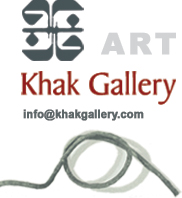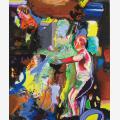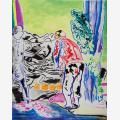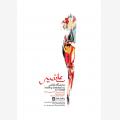
Visit Us
#1 Jila Alley, Basiri St. Gholhak
Shariati Ave. IRAN TEHRAN
TEL: (0098-21) 22 60 54 65
#1 Jila Alley, Basiri St. Gholhak
Shariati Ave. IRAN TEHRAN
TEL: (0098-21) 22 60 54 65
OFFICE
VILLA 21, 4B ST. , AL HUDAIBA 322 -
MARSAM MATTAR ART CENTER
Dubai - United Arab Emirates
A Review of Ali Nassir’s Exhibition at Khak Gallery ( فارسی )
SEND TO A FRIEND!Writen By AHMAD REZA DALVAND
Germans are familiar with him as a painter more than we Iranians are. He has taught at Berlin’s Hochschule der Künste (College of Arts), the TFH Berlin and the Summer Academy (Paderborn) in Berlin. From his first solo exhibition in the infamous NGBK Berlin, Ali Seyed Nassir exhibited signs of emergence of a different kind of painting; although that show only comprised a collection of his works as a student.It should be mentioned here that the NBGK was established by high class figures in German politics, law, literature and the arts, to act as a base for supporting talented and independent artists. The venue is considered one of the largest and most reputable in Berlin, following Berlin’s Contemporary Art Museum.
Ali Nassir moved to Germany during times in which the German visual arts scene was seriously influenced by the resurgence of expressionism; a movement referred to as “neo-expressionism”.
Expressionism is an art form demanding razor-sharp eyes, which penetrate the surface and delve into the deep. In expressionistic art, it is emotional content which affects the picture’s visual elements, and not necessarily direct observations. Deformation of visual elements are influenced more by the warmth of emotional content, rather than the artist’s visual knowledge. Meaning the more this event (creation of an expressionistic work of art considered an event here) takes place subconsciously and genuinely, the more purely and wholly the communication of the “expression” becomes.
For this reason, artists prove successful in this style who despite spiritual passion and fervor, enjoy a kind of intellectual integrity. In creation of an expressionistic work of art, the artist’s technical know-how and technique dissolve in the outburst of creativity and emotional power.
In the works of the founders of expressionism, in particular those of Edvard Munch (Norwegian painter and printmaker, member of the symbolist movement of the late nineteenth century and alongside Paul Gauguin a main proponent of expressionism in the twentieth century), a tendency toward poignant values is observed, with titles witnessed such as “The Sick Child,” or “The Dead Mother”.
This emphasis on emotional and melancholic aspects of life, was transferred to German expressionism through the influence of Edvard Munch.
Many art critiques have long considered expressionism a “literary” artform, while Paul Gauguin commented: “It is important for it to be art, be it literary or not”. Neo-expressionism is a movement which was formed toward the end of the 1970’s and the beginning of the 1980’s, spearheaded by the German artist Georg Baselitz. Other noteworthy mentions regarding the founding of this movement include Anselm Kiefer of Germany, a number of Italian painters, such as Francesco Clemente, Sandro Chia and Mimmo Paladino, and the American artist Julian Schnabel.
Neo-expressionism gained academic standing through residence of artists such as Salomé and Fetting at the Hochschule der Künste in Berlin, where it is being taught to younger generations. Influenced by this powerful art movement, Ali Nassir began to learn and experiment ardently and followed on at the Hochschule der Künste.
Nassir uses paint in a way such to create a kind of “psychological distance” in his works from the actual and tangible world.
Meaning, colors existing in a frame are absolutely not in logical accord with the concepts hidden within that same frame. This psychological distance originates from an inner destructiveness, created in contrast with a rainbow of the most joyous of colors by his contour lines and patterns.
The works of Ali Nassir bring to mind a poem by the Iraqi poet, Jamal Jumá: “We have stuck together. Out of fear? Or out of love?”
Ali Nassir displays “fear” with “line” and “love” with “color”.
In the painterly mannerisms of Ali Nassir, evil, darkness, destruction, violence, fear, threat and the rest are expressed through the element of “line”. However, he does not allow for any fear, threat or violence to enter the eye-pleasing vista of his colors. It is here where German expressionism has been unable to infiltrate his Eastern and Persian spirit. In Persian painting, colors lie bright and clear on the page, free from spiritual inclinations or psychological tendencies of the artist.
The real difference between the works of Ali Nassir and German expressionism lies in such a viewpoint. A viewpoint which has led to the birth of hybrid (nationality) artworks in his workshop; ones which reflect the unfamiliar distinctiveness and appeal of two different cultures within a unified and integrated mold. It is thus that a certain paradox is witnessed in the artwork of Ali Nassir; a paradox ultimately leading to an unanticipated and pleasing ambiguity.
Nassir has never made use of the acute violence and contradiction witnessed in color combinations attributed to German neo-expressionist painters; expressionism having only found its way into his work through lines. It could be said that his artworks are a blend of German expressionism with Persian colors. One interesting observation is that in the works of Ali Nassir one could not distinguish the precedence between the two elements line and color. At times expression of lines and at other times jubilation and festiveness of joyous colors grab one’s attention. And each time one is faced with the disconnection between wild colors and the melancholy within, reflected on the page through lines; a revelation akin to a perplexing vertigo.
On an initial glance, the sketches and paintings of Ali Nassir represent disjointed spaces and incidental and sentimental compositions. But this is just the surface.
Upon further scrutiny into the depths of these works, we realize the pure and genuine preoccupation of the artist with the essence of painting; one engrained within the creative subconscious, accompanied with commitment and devotion.
Despite his great ability in processing of abstract spaces, Ali Nassir has held a deep interest in the human figure. Progression of his thoughts and ideas in time could be traced through the aesthetic and philosophical developments which have gradually been imprinted on his human figures.
Initially, he used to draw people with distinct faces and intelligible psychology and spirit. During that time, he used to depict signs of deliberation, pain, fear and other human conditions within the facial lines and physique of his figures. The young painter reflected his personal feelings and internal emotions as such.
But gradually these feelings gave way to a more comprehensive consciousness and an increasingly philosophical outlook. As a result, humans portrayed in his works morphed into unfamiliar figures; figures devoid of psychology and free of any signs of sorrow or grief! Creatures of which only contour outlines remain.
During the next stage, these figures are demoted to lonesome creatures or ones grouped together. Drawing up a line in order to distinctly categorize Ali Nassir’s works is rather complex, as in creating those works he remains intrinsically loyal to a kind of creative agreement with himself; meaning there persists an inherent link and a continuance of method between his current and older works.
Any movement forward in Ali Nassir\'s works is representative of his previous movements. Any new discovery and evidence takes root and grows upon his older works. Each new window opened onto the world of colors and lines reveal former horizons. The constant and persisting presence of certain visual elements in the works of this artist are attributed to such manners and customs.
In the latest works of Ali Nassir, each figure or dimensional element bears its own unique perspective. Through this mechanism he has been able to dexterously convey human \"lonesomeness\" and \"individuality\" in hyper-industrial landscapes. Looking at these works, the viewer is confronted with the realization that all people and objects in this world are alone. The other method which he employs for portraying human loneliness in hyper-industrial landscapes is elimination of the horizon line in the visual composition of his pictures.
For centuries, courses in drawing and perspective in schools of art and architecture the world over have been based on the horizon line. This phenomenon, the horizon line, is so fundamental that lessons on drawing in nearly no art school could be carried out without a reference to it.
But, the lost (and lonesome) people portrayed in the artwork of Ali Nassir, who no longer bear any desires or wishes, and of whom nothing remains except mere contour lines, have long realized that hopes are boundless and unreachable, just like the line of horizon! Horizon line seems very close. It would seem that if you run toward it you could reach it within half an hour. But, one could never truly reach the line of horizon and it perpetually remains at the same unattainable distance.
There in effect exists no horizon. It is nothing but a mere illusion.
The sky at no point meets the earth. It only appears like it does. The figures of Ali Nassir, so miserable with this consciousness and loneliness, consider freedom and fortune as attainable as the line of horizon.
The wretched and desolate figures residing in Ali Nassir\'s pictures, no longer carry any confidence in the familiar world which is divided in two with a straight line, one half beneath their feet and the other above their heads.


